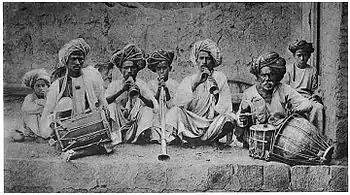Mang (caste)
The Mang community is an Indian caste mainly residing in the state of Maharashtra. The community was historically believed to be associated with Village security or professions such as rope making, broom making, village musicians, cattle castration, leather curing, midwifery, hangmen, and undertaking.[1] In modern day India, they are listed as a Scheduled Caste, Their origins lie in the Narmada Valley of India, and they were formerly classified as a criminal tribe under the Criminal Tribes Acts of the British Raj.[2]

.jpg.webp)
History
The mangs are known as 'Madiga' in southern part and 'Mangalas' in Gujarat. They are largely found in Maharashtra and neighbouring states. The mangs live on outskirt of villages. Their homes are typically resides to the north side of village. The mangs have three territorial divisions Madiga(south), Mangalas(Gujrat), Maratha Mangs who neither eat together nor intermarry. According to renowned historian Syed Siraj-Ul-Hassan mangs apart from territorial divisions divided into 25 endogamous subcastes, major subcastes include Assal Mangs/Maratha Mang, Bale, Bumd, Chapalsande, Holar, Dhor, Mochi, etc.The mangs are also divided into exogamous groups/clans. The marriage within the same group is prohibited. The mang professes Hinduism and worship all hindu gods."Bhavani Janakamma" is the caste deity of Mangs.They worship spirits and village deities like Pochamma and Maisamma, who according to them are responsible for all the good and bad that befalls the village community.Once in a year they celebrate Jatara for deity Maisamma, they sacrifice goat or sheep and enjoy a feast with its meat. Besides village deities, they also worship Rama, Krishna Bhagavan and also Hanuman.The mangs celebrates all hindu festivals important among them being Dassera, Makar Sankranti, Ugadi, Diwali, Maha Shivaratri, Kamunipurnima and Edlapolal.[3] Like Mahar, Mangs also served as soldier in king Shivaji's Army and British Army.
Distribution
Per the 1981 census, the majority of Mang lived in Maharashtra (1,211,335), with much smaller numbers in Gujarat (2,765); Goa, Daman, and Diu (702) and Rajasthan (241).
Society and culture
Before the British era, mangs were one of the twelve hereditary village servants called Bara Balutedar.The mangs were the hereditary rope makers and village entertainers.For their services they received a share of the village produce.The caste was hindu and observed the Hindu rituals of Jawal (first hair cut), shendi, lagna, and funerary rites.[4] In the early 20th century, the Mang began to form caste associations to advocate their cause, such as the Mang Samaj (1932) and Mang Society (1923).[5][6]
Notables
- Annabhau Sathe, Maharashtra social reformer
- Lahuji Raghoji Salve, Maharashtra social reformer
References
- Robert Vane Russell (1916). pt. II. Descriptive articles on the principal castes and tribes of the Central Provinces. Macmillan and Co., limited. pp. 188–. Retrieved 14 August 2012.
- Bates, Crispin (1995). "Race, Caste and Tribe in Central India: the early origins of Indian anthropometry". In Robb, Peter (ed.). The Concept of Race in South Asia. Delhi: Oxford University Press. p. 227. ISBN 978-0-19-563767-0. Retrieved 1 December 2011.
- http://lsi.gov.in:8081/jspui/bitstream/123456789/2806/1/41944_1961_ETH.pdf
- Krishnaji Nageshrao Chitnis (1994). Glimpses of Maratha Socio-economic History. Atlantic Publishers & Dist. pp. 125, 135. ISBN 978-81-7156-347-0.
- Surajit Sinha (1 January 1993). Anthropology of Weaker Sections. Concept Publishing Company. pp. 330–. ISBN 978-81-7022-491-4. Retrieved 24 August 2013.
- Prahlad Gangaram Jogdand (1991). Dalit movement in Maharashtra. Kanak Publications. Retrieved 24 August 2013.
Further reading
- Constable, Philip (May 2001). "The Marginalization of a Dalit Martial Race in Late Nineteenth- and Early Twentieth-Century Western India". The Journal of Asian Studies. 60 (2): 439–478. doi:10.2307/2659700. JSTOR 2659700. PMID 18268829.
| Wikimedia Commons has media related to Mang (caste). |